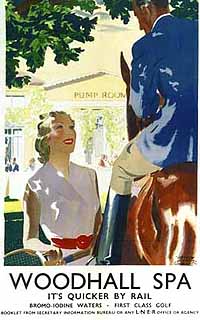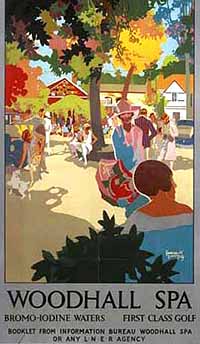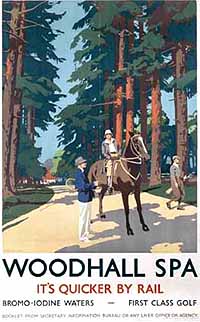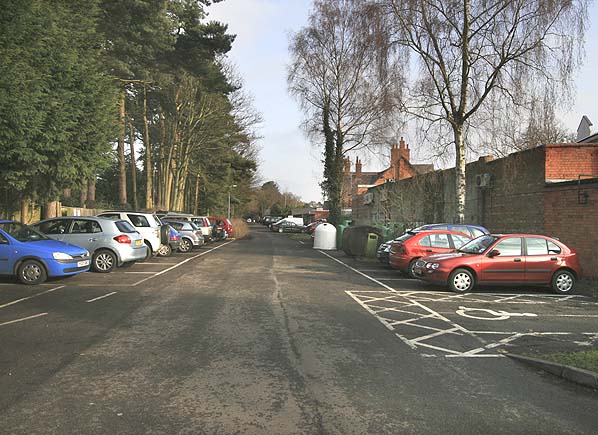Notes: When Woodhall Spa station opened it had one timber platform but as the village developed into a health resort the original wooden platform with its small waiting room was unable to cope with the number of visitors arriving at the resort by train.
 |
In 1888 the company bought more land to build a new station with better facilities. These included two timber platforms each with waiting rooms and a canopy, booking hall and a bookshop. The two platforms were spanned by a lattice footbridge adjacent to the level crossing and second signal box was provided in the centre of the northbound platform. The small goods |
goods yard which had a single siding on a loop and coal drops and was sited some distance to the south west of the passenger station on the up side of the line to the east of Tattershall Road. The original signal box controlled the level crossing and was sited on the opposite side of the crossing. The stationmaster's house was at the south end of the northbound platform, adjacent to the crossing.
The popularity of the Woodhall Spa as a health resort declined at the beginning of WW1 but the Woodhall Golf Course continued to attract many visitors in the 1920s and 30s. After closure to passengers in 1954 the station remained open for coal traffic until 27th April 1964.
BRIEF HISTORY OF THE HORNCASTLE & KIRKSTEAD JUNCTION RAILWAY
Before 1848 the only town in Lincolnshire served by a railway was Lincoln which was the terminus of a spur from Nottingham. On 17th October 1848 a line was opened from Peterborough to Lincoln via Boston where it joined the line running south from Grimsby that had opened in stages earlier that year.
In the early 1850s, Horncastle was an important regional centre which serviced a highly productive agricultural area that supplied corn, cattle, wool, and other produce to the heavily populated industrial areas of Lancashire and Yorkshire. It also held an important annual horse fair and other large stock markets. All it lacked was a rail connection.
The main line (Lincolnshire Loop Line) of the Great Northern Railway (GNR), the line which linked Boston to Lincoln, ran along the bank of the River Witham. There was a canal that joined Horncastle to the river near Dogdyke where there was a station. In 1851, in order to facilitate the transfer of coal and other heavy goods, the GNR built a coal wharf and warehouse at Horncastle as they didn't have any funds available for a rail connection. From there, coal was delivered to the surrounding villages. It soon became clear that the area would be better served by a railway link from Horncastle to the main line. |
 |
Without that, it was feared the town would decline as competition increased from the fairs and markets of other towns served by a railway.
In 1853, three local businessmen were instrumental in forming the Horncastle Railway Company. The objective was to construct a single line, less than eight miles in length, from the GNR's loop line at Kirkstead to Horncastle via the village of Woodhall.
 |
Negotiations were opened with the GNR and it was agreed that if the line were to be built the GNR would work it and that the revenue would be divided equally between the two companies. As a result, a Bill to permit the construction of the line, to be called the Horncastle and Kirkstead Junction Railway Company, was presented to parliament. This met determined |
opposition until it was revealed that the majority of the protesters had interests in the canal company. So, in July 1854, the Bill was passed.
 |
It had been hoped that the line would be open by 1st August 1854 but because of the severe winter of 1854/55, work didn’t start until March 1855. With no substantial earthworks, no tunnels and only one road bridge, construction was rapid and the line was completed by the beginning of August. Despite failing its Board of Trade Inspection, the official opening of the line took placed on the planned date 11th August 1855. The opening of the line was celebrated with great enthusiasm in Horncastle. There was a grand procession through the town led by banners, musicians, company officials, directors, shareholders and school children, with local people following behind.
Contractors worked hard to bring the line up to a safe standard in time for the forthcoming Horncastle Fair and the line was once again ready for inspection on 17th August. This time it was declared fit and opened immediately for passenger traffic and light goods with heavy goods being carried from 26th |
 |
September.
 |
The railway was a single track line just over 7 miles long. It left the GNR line at the small village of Kirkstead where there was a ferry over the river Witham. The junction faced Boston which meant that trains had to reverse after leaving the branch to reach the bay platform that was provided at Kirkstead. From there the line ran north-east through the village of |
Woodhall Spa where a station with a single platform was built. It carried on for another 3 miles, through a small cutting in a low spur of the Wolds, until it encountered the canal. It then ran northwards, alongside the canal, to Horncastle.
The branch was an immediate success with a large number of visitors travelling by rail to the annual horse fair and in order to build on this promising start the GNR offered cheap fairs to London and by the end of the year both passenger and freight revenue was healthy. A small dividend was first declared in September 1856 and dividends of up to 9% were being paid during the late 1880s.
| Before the end of the century there were several proposals to extend the line including the ill-fated Lincoln, Horncastle, Spilsby & East Coast Railway (HS&ECR) which received parliamentary authority on 16th September 1887 to build a line from Stixwould on the Lincolnshire Loop Line linking the Spilsby and Horncastle branches. The company was unable to raise |
 |
sufficient capital and the GNR declined an offer to take over the powers when the scheme was abandoned in 1891.
Unlike many other Lincolnshire lines, the Horncastle branch continued to be profitable and retained its independence until the 1923 Grouping when it came under the control of the LNER.
The line closed on or shortly after 11th September 1939 but reopened on 4th December of the same year. With the popularity of road transport after WW2 passenger numbers dropped dramatically and it now cost far more to work the line than the revenue from passenger receipts. In July 1952, the Railway Executive announced its intention to withdraw the passenger service which could be replaced by the existing bus service if it was re timed to meet trains arriving at Woodhall Junction. With an average of 21 passengers a day over a year compared with 355 using the bus service between Kirkstead and Horncastle the line was clearly not viable. The line would still handle bulk freight traffic although parcels would be distributed by road from Woodhall Junction.
 |
There was a vigorous local campaign to fight the closure which lasted two years and at one stage almost succeeded. When a much cheaper diesel railcar service was proposed for the branch, a sub-committee of the East Midlands Transport Users Consultative Committee was formed to discuss the proposals. In July 1953 three of the four members of the sub-committee reached the conclusion that the Railway Executive should withdraw its proposals to close the branch. The Railway Executive rejected the report and closure was announced for 13th September 1954.
With parcels being handled at Woodhall Junction, bulk freight traffic continued with the branch handling petrol, agricultural lubricating oils, artificial fertilizers, animal foodstuffs, heavy agricultural machinery, coal and tyres for agricultural vehicles until 6th April 1971 when the freight service was also withdrawn. |
Much of the trackbed between Horncastle and Woodhall Spa was bought by Lincolnshire County Council in 1975 is part of the long distance Viking Way public footpath.
Tickets from Michael Stewart, route map drawn by Alan Young
Sources: The Horncastle & Woodhall Junction Railway by AJ Ludlam. Published 1986 by Oakwood Press ISBN 0 85361 326 5. Woodhall Spa Community web site & Woodhall Spa Cottage Museum web site.
Other web sites:Lincolnshire & East Yorkshire Transport Review includes pictures of the line. Dave's Railpics of Lincolnshire. David Enefer's excellent web site crammed with pictures of Lincolnshire stations. Lincolnshire Railway's from the past Adam Cartwright's excellent web site crammed with pictures of Lincolnshire stations
To see other stations on the Horncastle Branch click on the station name:
Woodhall Junction & Horncastle |

old8.jpg)


old6.jpg)
old2.jpg)
old1.jpg)










old_thumb4.jpg)
old_thumb9.jpg)
old_thumb5.jpg)
old_thumb7.jpg)
old_thumb3.jpg)
old_thumb10.jpg)
old_thumb11.jpg)


 Home Page
Home Page